Future Range Expansions of Invasive Wasps Suggest Their Increasing Impacts on Global Apiculture
Abstract
:Simple Summary
Abstract
1. Introduction
2. Materials and Methods
2.1. Presence Records of the 12 Major Invasive Wasp Species
2.2. Predictors in the Study
2.3. Statistical Analysis
2.4. Predictor Selection
2.5. Developing the Species Distribution Models (SDMs)
2.6. Examining Habitat Suitability Dynamics
2.7. Examining the Range Dynamics
3. Results
3.1. Reliability of the SDMs
3.2. Main Predictors in the Baseline SDMs
3.3. Habitat Suitability Patterns and Their Dynamics
3.4. Invasive Wasp Species’ Potential Ranges
3.5. Range Dynamics of the Invasive Wasps
4. Discussion
5. Conclusions
Supplementary Materials
Author Contributions
Funding
Data Availability Statement
Acknowledgments
Conflicts of Interest
References
- Bradbear, N. Bees and Their Role in Forest Livelihoods. Non-Wood Forest Products; Food and Agriculture Organization of The United Nations: Rome, Italy, 2009; Volume 19. [Google Scholar]
- Wakgari, M.; Yigezu, G. Honeybee keeper constraints and future prospects. Cogent Food Agric. 2021, 7, 1872192. [Google Scholar] [CrossRef]
- Villemant, C.; Muller, F.; Haubois, S.; Perrard, A.; Darrouzet, E.; Rome, Q. Bilan des travaux (MNHN et IRBI) sur l’invasion en France de Vespa velutina, le frelon asiatique pre´dateur d’abeilles. In Proceedings of the Journe´e Scientifique Apicole, Arles, France, 1 February 2011; Barbançon, J.-M., L’Hostis, M., Eds.; ONIRIS-FNOSAD: Nantes, France, 2011; pp. 3–12. [Google Scholar]
- Cook, D.C. Quantifying the potential impact of the European wasp (Vespula germanica) on ecosystem services in Western Australia. NeoBiota 2019, 50, 55–74. [Google Scholar] [CrossRef]
- Laurino, D.; Lioy, S.; Carisio, L.; Manino, A.; Porporato, M. Vespa velutina: An alien driver of honey bee Colony losses. Diversity 2019, 12, 5. [Google Scholar] [CrossRef]
- Rankin, E.E.W. Emerging patterns in social wasp invasions. Curr. Opin. Insect Sci. 2021, 46, 72–77. [Google Scholar] [CrossRef]
- Matsuura, M. Ecological study on vespine wasps (Hymenoptera: Vespidae) attacking honeybee colonies: I. seasonal changes in the frequency of visits to apiaries by vespine wasps and damage inflicted, especially in the absence of artificial protection. Appl. Èntomol. Zool. 1988, 23, 428–440. [Google Scholar] [CrossRef]
- Matsuura, M.; Yamane, S. Biology of Vespine Wasps; Springer: Berlin, Germany, 1990. [Google Scholar]
- Cappa, F.; Cini, A.; Bortolotti, L.; Poidatz, J.; Cervo, R. Hornets and Honey Bees: A coevolutionary arms race between ancient adaptations and new invasive threats. Insects 2021, 12, 1037. [Google Scholar] [CrossRef]
- Rome, Q.; Muller, F.J.; Touret-Alby, A.; Darrouzet, E.; Perrard, A.; Villemant, C. Caste differentiation and seasonal changes in Vespa velutina (Hym.: Vespidae) colonies in its introduced range. J. Appl. Entomol. 2015, 139, 771–782. [Google Scholar] [CrossRef]
- Hathaway, M.A. Polistes gallicus in North America. Sphecos 1982, 5, 9–10. [Google Scholar]
- Jacobson, R.S. Polistes dominulus spreads. Sphecos 1991, 22, 9. [Google Scholar]
- Clapperton, B.K.; Alspach, P.A.; Moller, H.; Matheson, A.G. The impact of common and German wasps (Hymenoptera: Vespidae) on the New Zealand beekeeper industry. N. Z. J. Zool. 1989, 16, 325–332. [Google Scholar] [CrossRef]
- Harris, R.J.; Oliver, E.H. Prey diets and population densities of the wasps Vespula vulgaris and V. germanica in scrubland-pasture. N. Z. J. Ecol. 1993, 20, 5–12. [Google Scholar]
- Beggs, J.R.; Brockerhoff, E.G.; Corley, J.C.; Kenis, M.; Masciocchi, M.; Muller, F.; Rome, Q.; Villemant, C. Ecological effects and management of invasive alien Vespidae. BioControl 2011, 56, 505–526. [Google Scholar] [CrossRef]
- Monceau, K.; Bonnard, O.; Thiéry, D. Vespa velutina: A new invasive predator of honeybees in Europe. J. Pest Sci. 2014, 87, 1–16. [Google Scholar] [CrossRef]
- Monceau, K.; Bonnard, O.; Moreau, J.; Thiéry, D. Spatial distribution of Vespa velutina individuals hunting at domestic honeybee hives: Heterogeneity at a local scale. Insect Sci. 2014, 21, 765–774. [Google Scholar] [CrossRef] [PubMed]
- Abdullaev, U.R.; Abdullaev, I.I.; Masharipova, O.O. The Social Wasp Fauna and Biology of Khorezm Region (Hymenoptera, Vespidae: Vespinae, Polistinae). Int. J. Biol. 2019, 12, 14. [Google Scholar] [CrossRef]
- Moller, H.; Tilley, J.A.V. Beech honeydew: Seasonal variation and use by wasps, honey bees and other insects. N. Z. J. Zool. 1989, 16, 289–302. [Google Scholar] [CrossRef]
- Turchi, L.; Derijard, B. Options for the biological and physical control of Vespa velutina nigrithorax (Hym.: Vespidae) in Europe: A review. J. Appl. Entomol. 2018, 142, 553–562. [Google Scholar] [CrossRef]
- Masciocchi, M.; Corley, J. Distribution, dispersal and spread of the invasive social wasp (Vespula germanica) in Argentina. Austral Ecol. 2013, 38, 162–168. [Google Scholar] [CrossRef]
- Akre, R.D.; Davis, H.G. Biology and pest status of venomous wasps. Ann. Rev. Entomol. 1978, 23, 215–238. [Google Scholar] [CrossRef] [PubMed]
- Choi, M.B.; Kwon, O. Occurrence of Hymenoptera (wasps and bees) and their foraging in the southwestern part of Jirisan National Park, South Korea. J. Ecol. Environ. 2015, 38, 367–374. [Google Scholar] [CrossRef]
- Carisio, L.; Cerri, J.; Lioy, S.; Bianchi, E.; Bertolino, S.; Porporato, M. Impacts of the invasive hornet Vespa velutina on native wasp species: A first effort to understand population-level effects in an invaded area of Europe. J. Insect Conserv. 2022, 26, 663–671. [Google Scholar] [CrossRef]
- Bessa, A.S.; Carvalho, J.; Gomes, A.; Santarem, F. Climate and land-use drivers of invasion: Predicting the expansion of Vespa velutina nigrithorax into the Iberian Peninsula. Insect Conserv. Divers. 2016, 9, 27–37. [Google Scholar] [CrossRef]
- Sumner, S.; Bevan, P.; Hart, A.G.; Isaac, N. Mapping species distributions in two weeks using citizen science. Insect Conserv. Divers. 2019, 12, 382–388. [Google Scholar] [CrossRef]
- Kim, S.H.; Kim, D.E.; Lee, H.; Jung, S.; Lee, W.H. Ensemble evaluation of the potential risk areas of yellow-legged hornet distribution. Environ. Monit. Assess. 2021, 193, 601. [Google Scholar] [CrossRef] [PubMed]
- Lioy, S.; Carisio, L.; Manino, A.; Porporato, M. Climatic niche differentiation between the invasive hornet Vespa velutina nigrithorax and two native hornets in Europe, Vespa crabro and Vespa orientalis. Diversity 2023, 15, 495. [Google Scholar] [CrossRef]
- Otis, G.W.; Taylor, B.A.; Mattila, H.R. Invasion potential of hornets (Hymenoptera: Vespidae: Vespa spp.). Front. Insect Sci. 2023, 3, 1145158. [Google Scholar] [CrossRef] [PubMed]
- Howse, M. Ecological impact and spread of an invasive paper wasp in New Zealand (Hymenoptera: Vespidae). Doctoral Dissertation, Open Access Te Herenga Waka-Victoria University of Wellington, Wellington, New Zealand, 2021. [Google Scholar]
- Nie, P.; Cao, R.; Yang, R.; Feng, J. Future range dynamics of Asian yellow-legged hornets (Vespa velutina) and their range overlap with Western honey bees (Apis mellifera) reveal major challenges for bee conservation in Europe. Pest Manag. Sci. 2024, 80, 7987. [Google Scholar] [CrossRef]
- Ramanantoanina, A.; Hui, C.; Ouhinou, A. Effects of density-dependent dispersal behaviours on the speed and spatial patterns of range expansion in predator–prey metapopulations. Ecol. Model. 2011, 222, 3524–3530. [Google Scholar] [CrossRef]
- Verdasca, M.J.; Rebelo, H.; Carvalheiro, L. Invasive hornets on the road: Motorway-driven dispersal must be considered in management plans of Vespa velutina. NeoBiota 2021, 69, 177–198. [Google Scholar] [CrossRef]
- De Villiers, M.; Kriticos, D.J.; Veldtman, R. Including irrigation in niche modelling of the invasive wasp Vespula germanica (Fabricius) improves model fit to predict potential for further spread. PLoS ONE 2017, 12, e0181397. [Google Scholar] [CrossRef]
- Alaniz, A.J.; Carvajal, M.A.; Vergara, P.M. Giants are coming? Predicting the potential spread and impacts of the giant Asian (Vespa mandarinia, Hymenoptera: Vespidae) in the USA. Pest Manag. Sci. 2017, 77, 104–112. [Google Scholar] [CrossRef] [PubMed]
- Nuñez-Penichet, C.; Osorio-Olvera, L.; Gonzalez, V.H.; Cobos, M.E.; Jiménez, L.; DeRaad, D.A.; Alkishe, A.; Contreras-Díaz, R.G.; Nava-Bolaños, A.; Utsumi, K.; et al. Geographic potential of the world’s largest hornet, Vespa mandarinia Smith (Hymenoptera: Vespidae), worldwide and particularly in North America. PeerJ 2021, 9, e10690. [Google Scholar] [CrossRef] [PubMed]
- Ruiz-Utrilla, Z.P.; del-Val, E.; Equihua, J.; Cuervo-Robayo, Á.P. Risk of Asian hornet invasion in Mexico: A proposal for invasive species risk assessment from a spatial perspective. Biodivers. Conserv. 2024, 33, 1751–1773. [Google Scholar] [CrossRef]
- Ebrahimi, E.; Carpenter, J.M. Distribution pattern of the hornets Vespa orientalis and V. crabro in Iran: (Hymenoptera: Vespidae). Zool. Middle East 2012, 56, 63–66. [Google Scholar] [CrossRef]
- Bertolino, S.; Lioy, S.; Laurino, D.; Manino, A.; Porporato, M. Spread of the invasive yellow-legged hornet Vespa velutina (Hymenoptera: Vespidae) in Italy. Appl. Entomol. Zool. 2016, 51, 589–597. [Google Scholar] [CrossRef]
- Moo-Llanes, D.A. Inferring distributional shifts of Asian giant hornet Vespa mandarinia Smith in climate change scenarios. Neotrop. Entomol. 2021, 50, 673–676. [Google Scholar] [CrossRef] [PubMed]
- Fick, S.E.; Hijmans, R.J. WorldClim2: New 1km spatial resolution climate surfaces for global land areas. Int. J. Climatol. 2017, 37, 4302–4315. [Google Scholar] [CrossRef]
- Zhang, M.Z.; Xu, Z.F.; Han, Y.; Guo, W.D. Evaluation of CMIP6 models toward dynamical downscaling over 14 CORDEX domains. Clim. Dyn. 2022, 58, 1–14. [Google Scholar] [CrossRef]
- Nie, P.; Feng, J. Niche and Range Shifts of Aedes aegypti and Ae. albopictus Suggest That the Latecomer Shows a Greater Invasiveness. Insects 2023, 14, 810. [Google Scholar] [CrossRef] [PubMed]
- Nie, P.; Yang, R.; Cao, R.; Hu, X.; Feng, J. Niche and Range Shifts of the Fall Webworm (Hyphantria cunea Dury) in Europe Imply Its Huge Invasion Potential in the Future. Insects 2023, 14, 316. [Google Scholar] [CrossRef] [PubMed]
- Thuiller, W.; Lafourcade, B.; Engler, R.; Araujo, M.B. BIOMOD—A platform for ensemble forecasting of species distributions. Ecography 2009, 32, 369–373. [Google Scholar] [CrossRef]
- Barbet-Massin, M.; Jiguet, F.; Albert, C.H.; Thuiller, W. Selecting pseudo-absences for species distribution models: How, where and how many? Methods Ecol. Evol. 2012, 3, 327–338. [Google Scholar] [CrossRef]
- Cao, R.Y.; Gong, X.; Feng, J.M.; Yang, R.J. Niche and range dynamics of Tasmanian blue gum (Eucalyptus globulus Labill.), a globally cultivated invasive tree. Ecol. Evol. 2022, 12, e9305. [Google Scholar] [CrossRef] [PubMed]
- Yang, R.J.; Cao, R.Y.; Gong, X.; Feng, J.M. Large Shifts of Niche and Range in the Golden Apple Snail (Pomacea Canaliculata), an Aquatic Invasive Species. Ecosphere 2023, 14, e4391. [Google Scholar] [CrossRef]
- Liu, C.; Newell, G.; White, M. On the selection of thresholds for predicting species occurrence with presence–only data. Ecol. Evol. 2016, 6, 337–348. [Google Scholar] [CrossRef] [PubMed]
- Tribe, G.D.; Richardson, D. The European wasp, Vespula germanica (Fabricius) (Hymenoptera: Vespidae), in southern Africa and its potential distribution as predicted by ecoclimatic matching. Afr. Entomol. 1994, 2, 1–6. [Google Scholar]
- D’adamo, P.; Sackmann, P.; Corley, J.C.; Rabinovich, M. The potential distribution of German wasps (Vespula germanica) in Argentina. N. Z. J. Zool. 2002, 29, 79–85. [Google Scholar] [CrossRef]
- Sorvari, J. Habitat preferences and spring temperature-related abundance of German wasp Vespula germanica in its northern range. Insect Conserv. Divers. 2018, 11, 363–369. [Google Scholar] [CrossRef]
- Abou-shaara, H.F.; Al-khalaf, A.A. Using maximum entropy algorithm to analyze current and future distribution of the Asian hornet, Vespa velutina, in Europe and North Africa under climate change conditions. J. Entomol. Res. Soc. 2022, 24, 7–21. [Google Scholar] [CrossRef]
- Sirami, C.; Caplat, P.; Popy, S.; Clamens, A.; Arlettaz, R.; Jiguet, F. Impacts of global change on species distributions: Obstacles and solutions to integrate climate and land use. Glob. Ecol. Biogeogr. 2017, 26, 385–394. [Google Scholar] [CrossRef]
- Addison, P.; Veldtman, R.; Van Zyl, C. The invasive Vespidae in South Africa: Potential management strategies and current status. Afr. Entomol. 2018, 26, 267–285. [Google Scholar]
- Howse, M.W.; Haywood, J.; Lester, P.J. Bioclimatic modelling identifies suitable habitat for the establishment of the invasive European paper wasp (Hymenoptera: Vespidae) across the southern hemisphere. Insects 2020, 11, 784. [Google Scholar] [CrossRef] [PubMed]
- Cao, R.; Feng, J. Future Climate Change and Anthropogenic Disturbance Promote the Invasions of the World’s Worst Invasive Insect Pests. Insects 2024, 15, 280. [Google Scholar] [CrossRef] [PubMed]
- Lowe, S.; Browne, M.; Boudjelas, S.; De Poorter, M. 100 of the World’s Worst Invasive Alien Species: A Selection from the Global Invasive Species Database; Invasive Species Specialist Group: Auckland, New Zealand, 2000; Volume 12. [Google Scholar]
- Luque, G.M.; Bellard, C.; Bertelsmeier, C.; Bonnaud, E.; Genovesi, P.; Simberloff, D.; Courchamp, F. The 100th of the world’s worst invasive alien species. Biol. Invasions 2014, 16, 981–985. [Google Scholar] [CrossRef]
- Hirsch, P.E.; N’Guyen, A.; Adrian-Kalchhauser, I.; Burkhardt-Holm, P. What do we really know about the impacts of one of the 100 worst invaders in Europe? A reality check. Ambio 2016, 45, 267–279. [Google Scholar] [CrossRef] [PubMed]
- Lester, P.J.; Beggs, J.R. Invasion success and management strategies for social Vespula wasps. Ann. Rev. Entomol. 2019, 64, 51–71. [Google Scholar] [CrossRef] [PubMed]
- Schmack, J.M.; Schleuning, M.; Ward, D.F.; Beggs, J.R. Biogeography and anthropogenic impact shape the success of invasive wasps on New Zealand’s offshore islands. Divers. Distrib. 2020, 26, 441–452. [Google Scholar] [CrossRef]
- Spencer, E.E.; Barton, P.S.; Ripple, W.J.; Newsome, T.M. Invasive European wasps alter scavenging dynamics around carrion. Food Webs 2020, 24, e00144. [Google Scholar] [CrossRef]
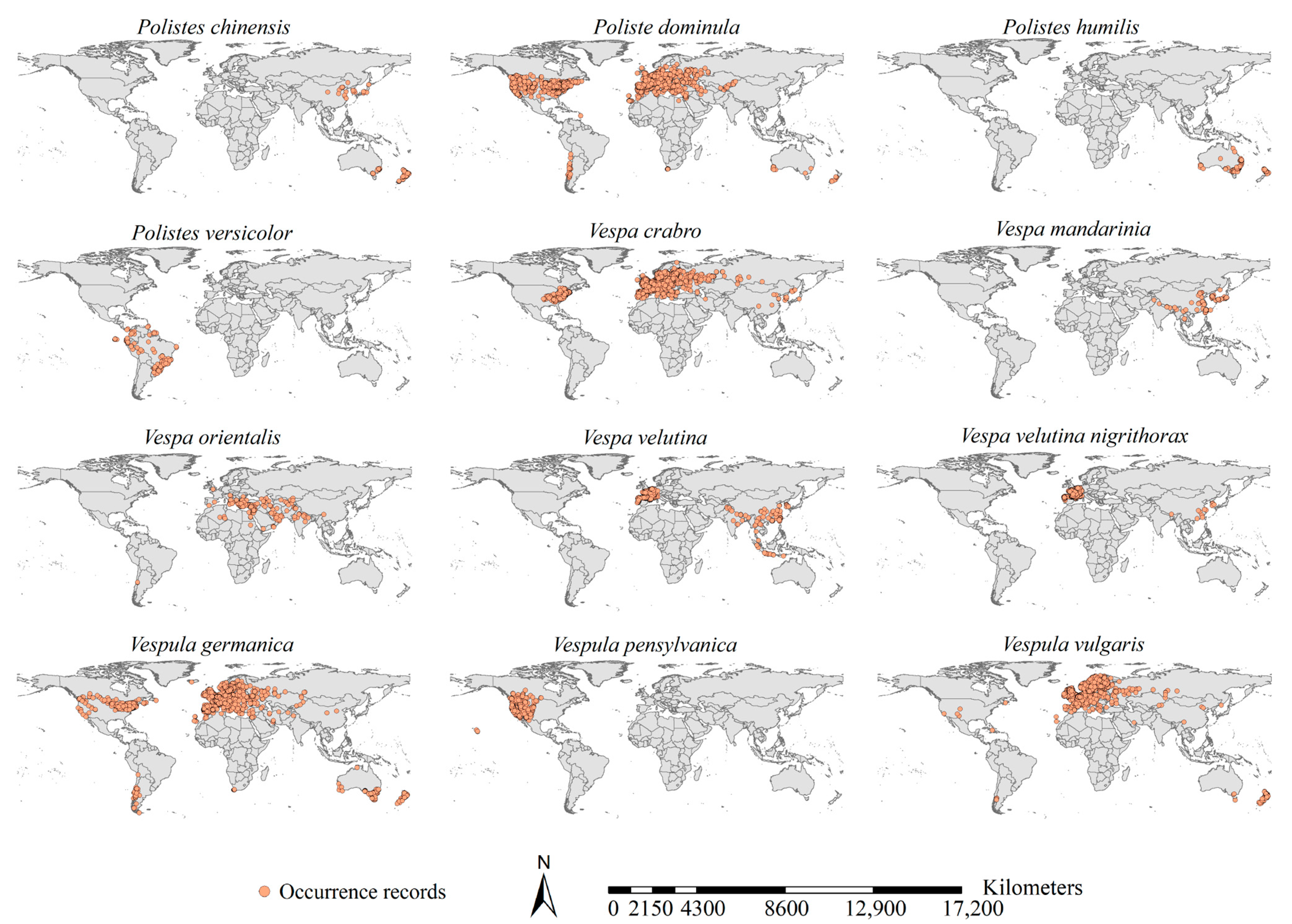

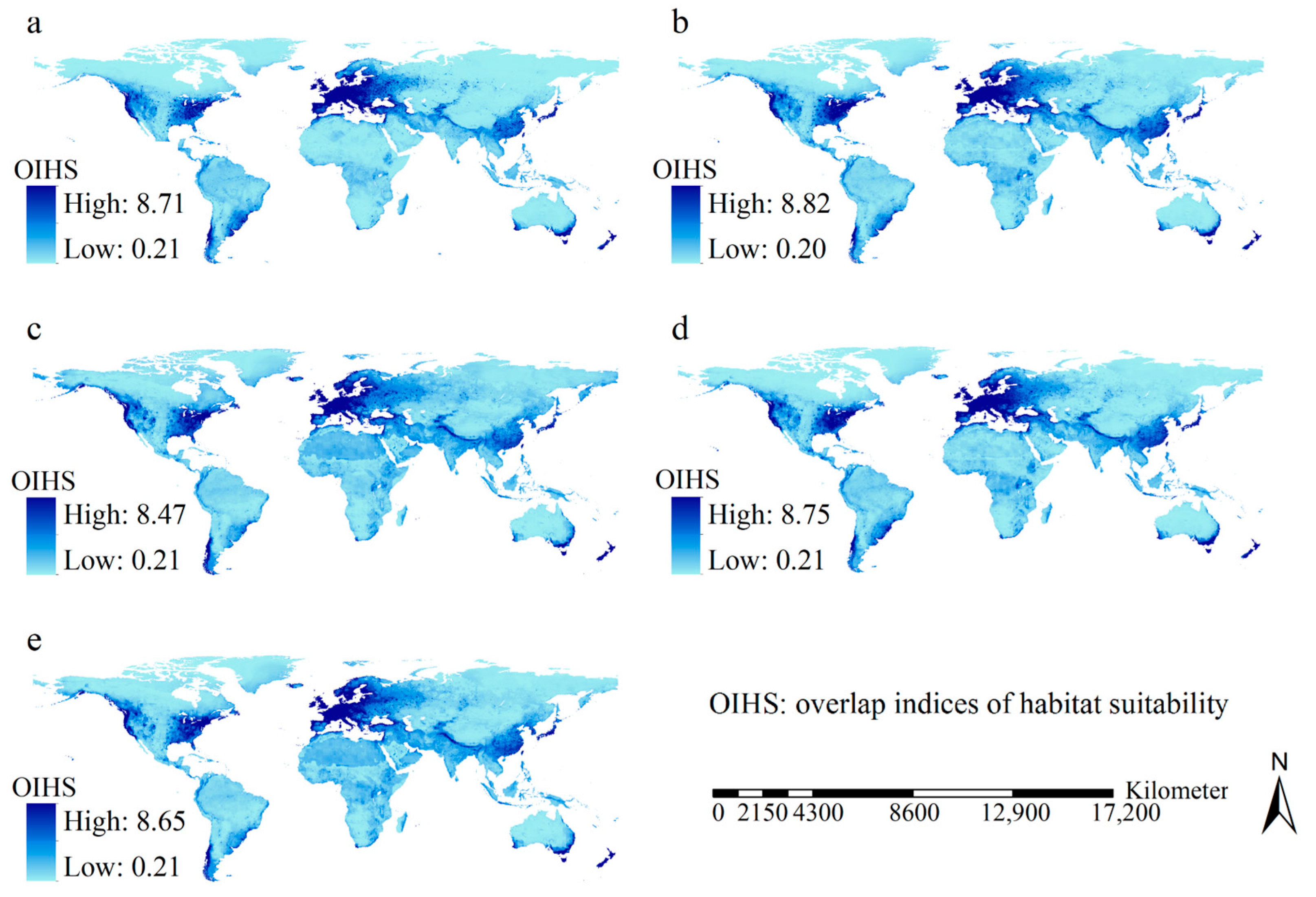
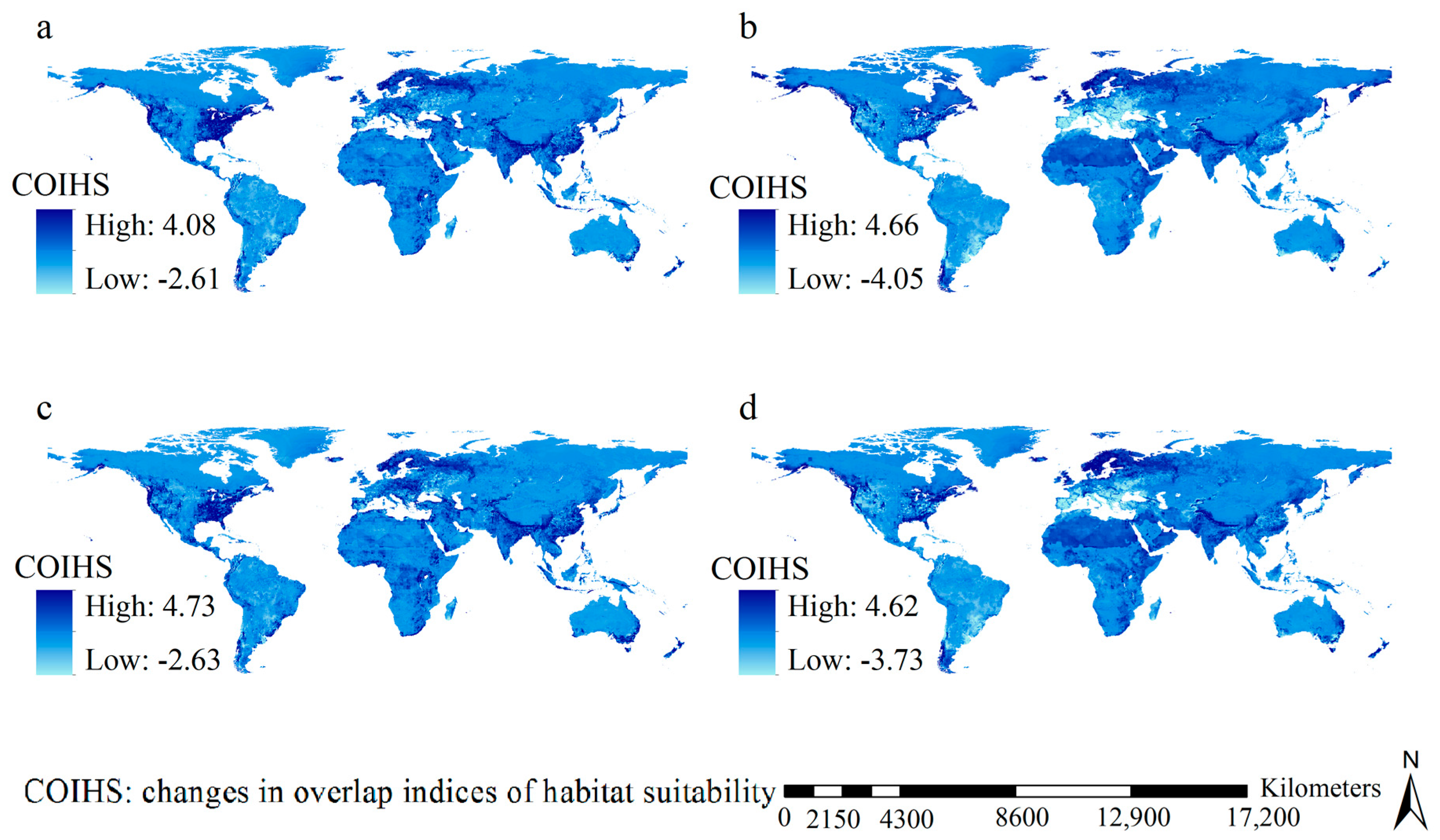
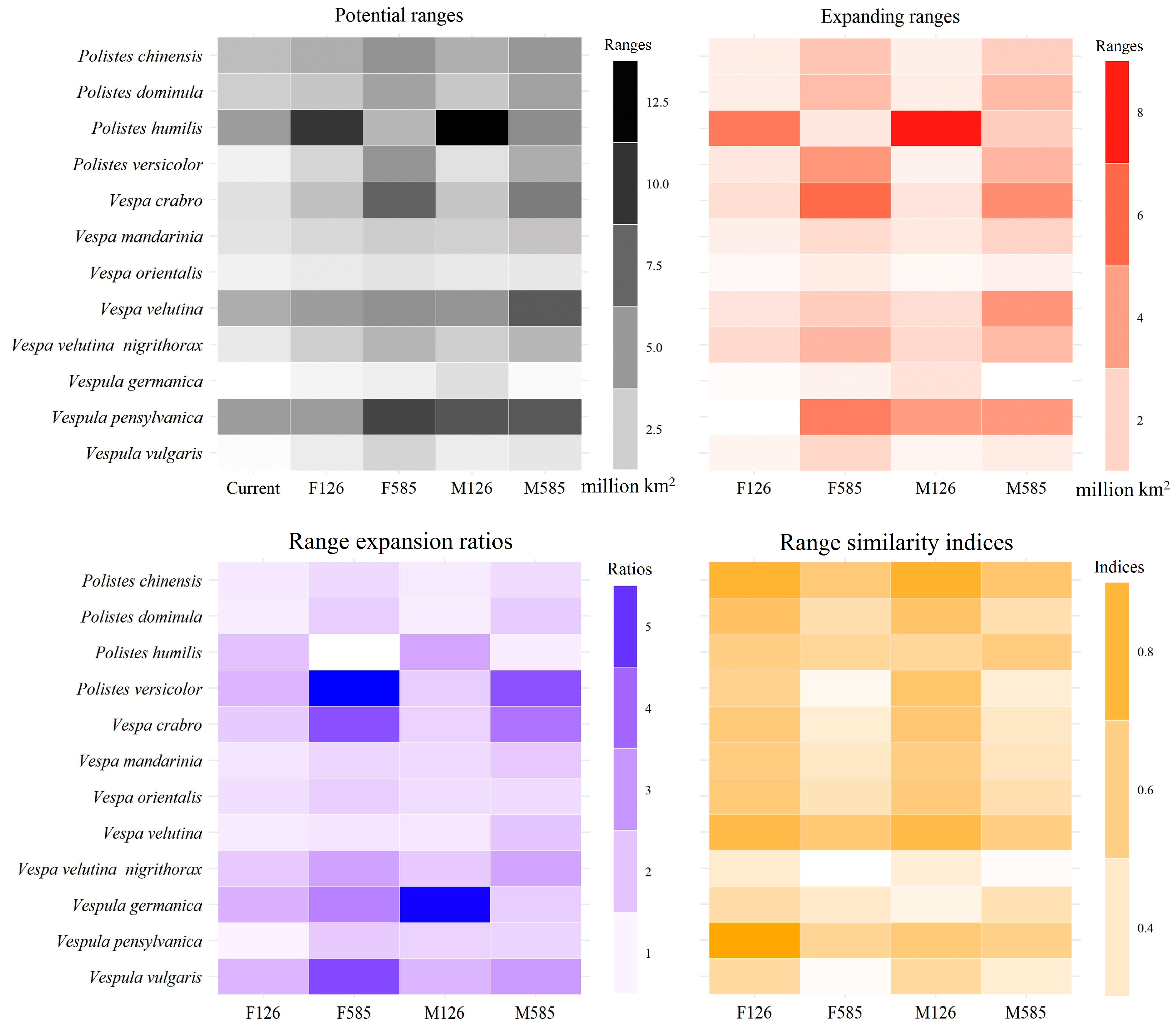
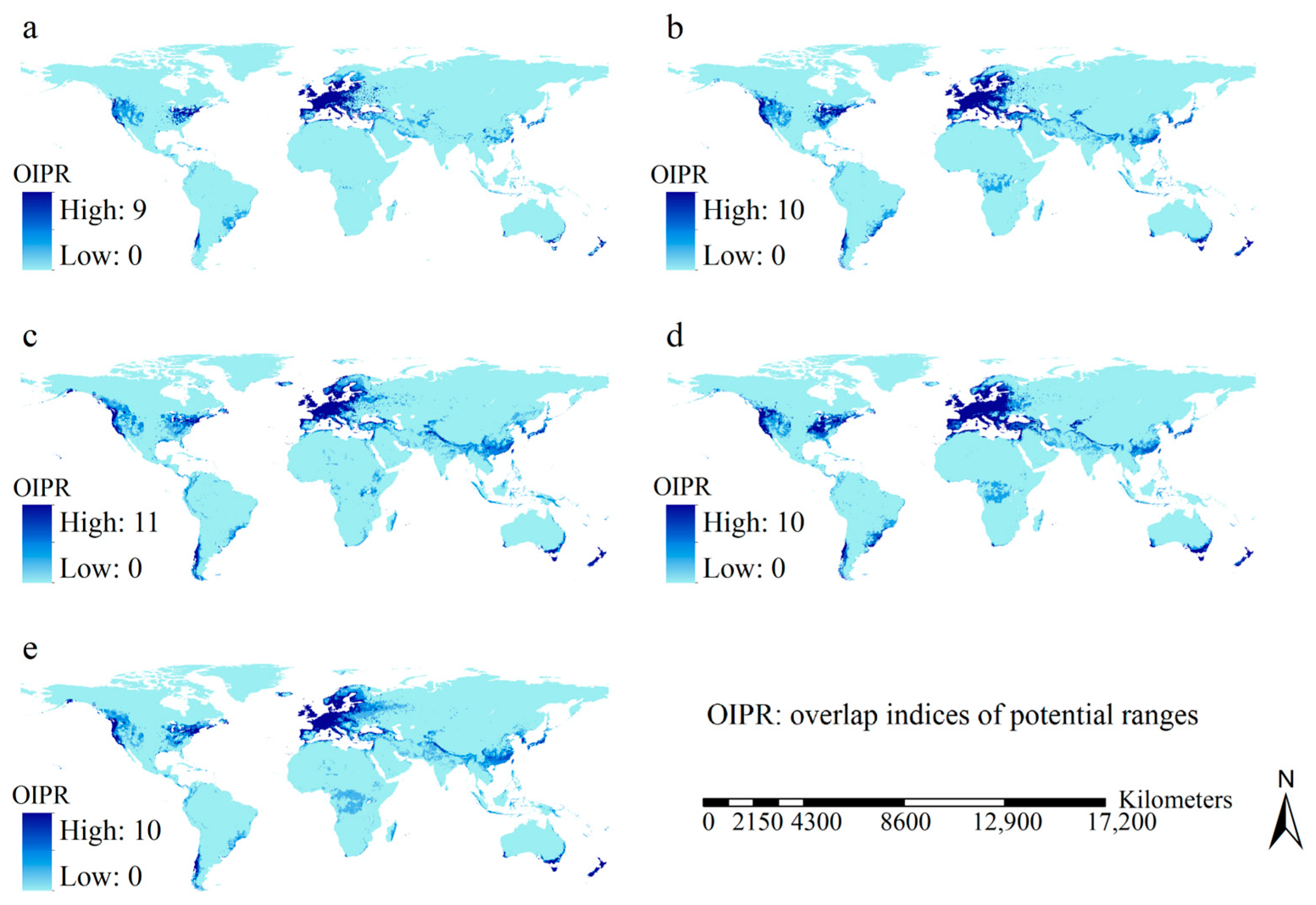

Disclaimer/Publisher’s Note: The statements, opinions and data contained in all publications are solely those of the individual author(s) and contributor(s) and not of MDPI and/or the editor(s). MDPI and/or the editor(s) disclaim responsibility for any injury to people or property resulting from any ideas, methods, instructions or products referred to in the content. |
© 2024 by the authors. Licensee MDPI, Basel, Switzerland. This article is an open access article distributed under the terms and conditions of the Creative Commons Attribution (CC BY) license (https://creativecommons.org/licenses/by/4.0/).
Share and Cite
Zhang, X.; Nie, P.; Hu, X.; Feng, J. Future Range Expansions of Invasive Wasps Suggest Their Increasing Impacts on Global Apiculture. Insects 2024, 15, 546. https://doi.org/10.3390/insects15070546
Zhang X, Nie P, Hu X, Feng J. Future Range Expansions of Invasive Wasps Suggest Their Increasing Impacts on Global Apiculture. Insects. 2024; 15(7):546. https://doi.org/10.3390/insects15070546
Chicago/Turabian StyleZhang, Xueyou, Peixiao Nie, Xiaokang Hu, and Jianmeng Feng. 2024. "Future Range Expansions of Invasive Wasps Suggest Their Increasing Impacts on Global Apiculture" Insects 15, no. 7: 546. https://doi.org/10.3390/insects15070546





